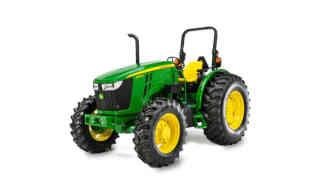If you need a utility tractor that can handle everything from roadside tasks to farming duties, you know you can turn to John Deere for the machinery you need. The John Deere 5075M is one example of a utility tractor that can handle a wide array of tasks, and nothing is too challenging for this robust piece of equipment. The 5075M is a part of the 5M Series line from John Deere, which boasts premium features and several different transmission options.

What is the John Deere 5075M?
The John Deere 5075M is a utility tractor that is a part of the company’s 5M Series line. As a utility tractor, the machine is designed to help operators take on several different tasks, ranging from mowing hay to snow removal. Generally speaking, utility tractors are moderately sized when compared to compact utility tractors. They also tend to provide more horsepower and offer attachment options that allow them to tackle projects that smaller machines cannot accomplish.
What Can the John Deere 5075M Do?
The John Deere 5075M can handle many tasks around the farm and beyond, which is why John Deere customers often invest not only in the 5075M but also in other machines in the 5M Series. With its multiple transmission options, the 5075M always provides a smooth ride, regardless of any challenging terrain it may encounter. Operators also have the option of two-wheel drive or Mechanical Front Wheel Drive (MFWD) to suit their personal preferences. With premium transmission options and ample horsepower, the John Deere 5075M can tackle everything from the transportation of other equipment to hauling hay.
Important Features of the John Deere 5075M
There are several important features of the 5075M that should be taken into consideration by customers before they make the investment. Specifics, such as the amount of horsepower the utility tractor provides, should be examined to ensure the utility tractor is a good fit. Here is a closer look at the most critical features of the John Deere 5075M, as well as how they can make your daily tasks easier to complete.
PowrReverser™ 16F/16R and 32F/16R Hi-Lo Transmission Options
There are two different transmission options available for the 5075M, one of which is the PowrReverser™ 16F/16R. This transmission has 16 forward speeds and 16 reverse speeds, and dual speed 540/540 economy power take-off comes standard. Its hydraulic wet clutches extend its lifespan by enhancing durability, and platform-mounted shift levers make it easy for operators to change gears.
The PowrReverser™ transmission also has an engagement override valve for more safety. Operators seeking more speed control can opt for the PowrReverser™ Hi-Lo 32F/16R transmission. This provides transport speeds up to 25 miles per hour, and operators can enjoy clutch-free hydraulic shifting between forward and reverse gears. The electrohydraulic hi-lo selector offers a 20% increase or decrease in speed for each forward gear as well.
PowerTech™ Diesel Engine
The PowerTech™ diesel engine of the John Deere 5075M is EPA-certified Tier Level 4, thanks to its diesel oxidation catalyst and diesel particulate filter combination. Through its regeneration process, the diesel particulate filter is efficiently cleaned out. The engine itself has low friction, high-ring pistons with a cast aluminum design. It also features a full-pressure lubrication system to reduce heat and has an electric fuel shutoff.
Heavy-Duty 3-Point Hitch Lift Capacity
The heavy-duty 3-point hitch of the John Deere 5075M gives operators the ability to raise and lower a wide range of implements, including field cultivators, sprayers, and planters. It is also possible to adjust the speed at which the implement is lowered. With adjustable sway bars, interchangeable hitch balls, and telescoping draft links, it’s easier than ever to hook up implements as needed.
Click here to see more...